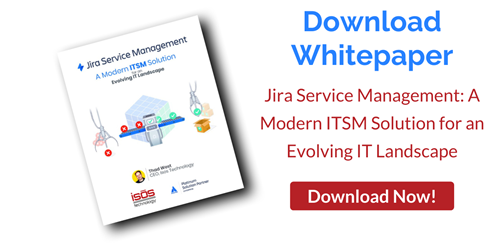
Atlassian takes an integrated approach to ITSM—all their tools work together to help teams deliver better services to both internal and external customers. However, Jira Service Management (JSM)—which is built on Jira and is essentially an extension of it—serves as a hub where the tools and processes come together so that IT teams across infrastructure, development, operations, and workplace support, have a single place to go for self-service, to set up automated workflows, to access custom dashboards, and much more.
In our previous blog post on Jira Service Management, we explored how it streamlines service delivery. In this blog post, we’ll explore one of the most important ways JSM streamlines service operations—as a centralized hub that integrates with both Atlassian and third-party tools, so IT operations and support teams, and even development teams, can work together to resolve incidents as quickly and efficiently as possible.
Jira Service Management: Providing Context and Enabling Collaboration for Incident Management
IT operations teams play a significant role in keeping services running on a day-to-day basis, but when an incident occurs, whether major or minor, it takes cross-functional collaboration across IT operations, development, and support teams to resolve it. Incident resolution can be extraordinarily complex: everyone involved needs to have access to the same information about the affected systems and their dependencies, current and historical information about the issue, and what work is underway to resolve. They need this information all in one place, so they don’t have to log in and out of systems, and they need real-time tracking of the issue to be a light lift.
While it may be necessary to leverage any number of integrated Atlassian tools to resolve an issue, JSM is the beating heart of this process. It’s the place where both internal employees and customers go to report an issue, and it’s set up to capture all the relevant information about it in a consistent way. If the incident is serious enough to warrant it, the support team can easily escalate it to the incident management team, and as they do, all that context around the issue goes right along with it, so the support, operations, and development teams have the information they need to collaborate and resolve it.
Streamlining Incident Management with Key Jira Service Management Integrations
As the incident management hub, Jira Service Management not only integrates with other Atlassian tools to streamline operations around incident resolution, it also easily integrates with a host of other third-party tools. Following are several key JSM integrations that streamline operations around incident management.
-
Opsgenie
Opsgenie is Atlassian’s tool for scheduling teams to be on call in the event of an incident and alerting them when needed, and although it integrates with hundreds of third-party incident management tools, it has a great two-way integration with JSM. When a new issue is created in JSM, it automatically triggers an alert in Opsgenie with information about it. Then, when the alert is snoozed, responded to, or even closed, that information is pushed back to JSM and automatically updated there. -
Statuspage
Statuspage is Atlassian’s tools for keeping internal stakeholders informed about the status of critical services, including both incidents and planned downtime. Statuspage also integrates with JSM’s customer portal so that if a there is an incident, a banner gets posted to the home page to let customers know what’s going on. That way, when an incident happens, teams don’t have to spend valuable time informing users, and they also don’t get inundated with tickets about the same incident. -
Insight for Jira Service Management
Atlassian acquired Insight—a tool for tracking assets and understanding their dependencies—from Mindville in 2020, and went on to improve its functionality. Today, when an incident occurs, teams can use Insight for JSM to get visibility into impacted services and how they related to other services, which helps in understanding the scope of an issue and resolving it—without inadvertently creating other issues. -
Third Party Monitoring Tools
IT operations teams often rely on at least one, if not a whole suite, of third-party monitoring tools like Datadog, Sumo Logic, and Nagios to detect issues or outages and send alerts. JSM integrates with more than 200 of the most popular app and web monitoring tools, so the operations team can receive and view all their alerts in one place.
Tracking the Incident in Real Time—and Automatically Generating Reports Later
During an incident, everyone is so focused on getting things done, that it’s hard to take time to document everything—but it’s a critical step to make sure the incident doesn’t happen again! Since Jira Service Management serves as the central hub for tracking the incident, and everything is recorded there, it’s easy to develop a history of the incident without taking any extra steps. After the incident is resolved, an incident timeline and a post-mortem report that includes root cause, lead-up, mitigation, resolution, and lessons learned can be automatically generated.
Interested in learning more about Jira Service Management? Contact us today!
Sign up to receive more great content
Learn more about Atlassian and how Isos can help by signing up to receive our latest blogs, eBooks, whitepapers and more.














